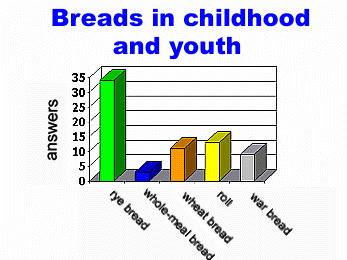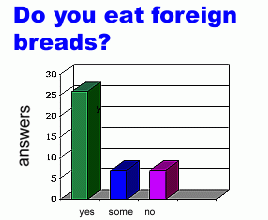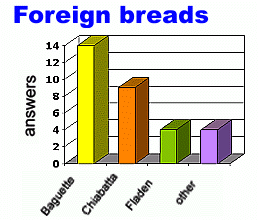 |
[ZAWiW] [gemeinsamlernen] [LiLL] | ||
|
Page 1 of 7
|
|
|
| home | ||
|
|
Introduction | |
|
|
Questionnaire | |
|
|
Result Analysis | |
 |
||
Result Analysis
Stand:a. Which bread types (also roles) did you eat in your childhood and youth? |
b. Which bread do you like best today?
besten?  |
c. Do you like bread from other countries?
 |
 |
Rye bread (correctly: rye mix bread) is most
frequently mentioned in questions a) and b). More than half of the questioned
persons have eaten this bread in their childhood and youth and it is the bread
type which still today is liked best. In south of Germany this bread type is
also called "black bread". It is simply the German standard bread type
which is eaten since many hundreds years.
In former time wheat flour was more expensive than rye flour and it was not so
much grown as today.. Therefore wheat bread and roles were considered as "luxury
products", which quite often are eaten only on Sunday and on festivals,
which for some people is still valid today On the other side the young people of
today prefer white types of bread like toast bread, wheat bread and baguette.
War bread (in Germany also called "Kommissbrot"(army bread) was mentioned only by relatively few persons who have actively experienced the war time (older than 65 years).This is a rye bread which is relatively hard and long lasting. Quotation of a man, 70 years old: "There was also available Kommissbrot , but we did not like it. In the army we had to eat it."
Whole meal (black) bread and bread with grains and seeds have increased their popularity especially with people of the older generation. It seems that the aspect of health is playing a role. Scientists of nutrition recommend bread rich of grains because of the high amount of fibre content and for better digestion.
Bread quality plays an important role in Germany, but the criteria of bread quality is quite different.
For Rye and a Rye Mix Bread and Whole Meal Bread this criteria is
- a light to strong sour taste
- the crumb must have an even fine texture
- good slicing property
- it should have a nice crust
For Wheat Bread and Rolls it is
- a little sweet taste
- an uneven open crumb texture
From the different bread quality criteria results a different type of spreading: Rye mix bread with sausage, cold meat cut, white bread (rolls) with jam, honey or cheese.
Quotations
A lady from Ulm, 61 years: "Now my husband and I like very much a bread of
hearty taste and with a nice crust. We like to change the types of bread."
"It is less that the taste of bread that has change, but there are offered
more varieties."
Bread types from other countries
More than half of the inquired people said that they do like bread from other countries. The French Baguette and the Italian Ciabatta are heading the ranking of most liked bread types. Also flat bread was mentioned quite often. But there were also contrary voices refusing foreign bread or believing that they never tasted it. It seems that some consumers don't consider the Baguette (also called bread sticks) as a foreign bread type.
Summary
The fact that the Germans use to eat relatively much bread and even twice a day (breakfast and supper) has lead to a double part of consumers habits, which is
- people stick to their traditional rye and rye mix bread
- people are open to other and even new types of bread
The Germans use to eat bread mostly spread and less as
addition to the main meal like in southern countries.
The higher amount of bought bread is produced by artisan bakers whereas
industrial packed bread has an market share of 25-30%. For the "artisan-bread"
freshness and the big variety of the assortment is the most important argument.
Industrial bread, however, is cheaper and therefore bought by people of lower
income.
